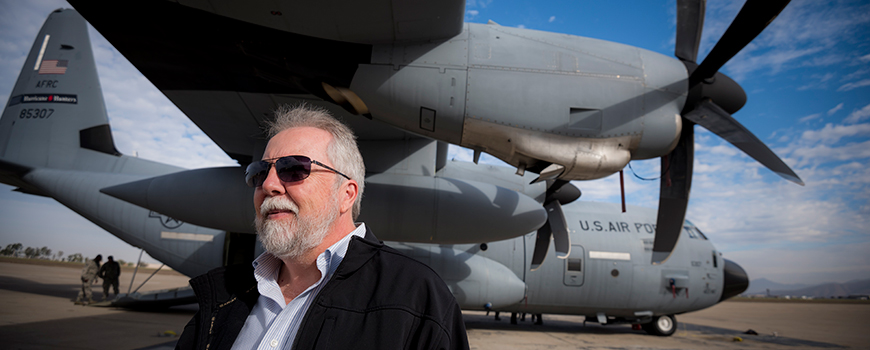Global S&T Development Trend Analysis Platform of Resources and Environment
| Scripps Institution of Oceanography, Air Force, NOAA Poised to Probe Atmospheric Rivers | |
| admin | |
| 2018-01-26 | |
| 发布年 | 2018 |
| 语种 | 英语 |
| 国家 | 美国 |
| 领域 | 资源环境 |
| 正文(英文) |  CW3E Director Marty Ralph with WC-130J aircraft at San Diego's Brown Field. Photo: Erik Jepsen Atmospheric rivers are long, narrow bands of moisture that can deliver up to half of California’s annual water supply in a matter of days. Scientists led by Scripps Institution of Oceanography at UC San Diego, in partnership with NOAA’s National Weather Service, are now on standby to intercept these storms headed to the West Coast over the Pacific Ocean and gather vital information on their characteristics as they fly through them. The U.S. Air Force Reserve “Hurricane Hunters” will station WC-130J Super Hercules aircraft at the U.S. Coast Guard Air Station Barbers Point in Hawaii and at Travis Air Force Base in Vacaville, Calif., and NOAA will station a Gulfstream IV (G-4) aircraft outside of Seattle, Wash. The flights are intended to be scheduled on short notice based on evolving forecasts as atmospheric rivers develop. During these flights, crew members will deploy dropsondes from the interior of the aircraft at selected locations in transects across atmospheric river storms. The dropsondes carry instruments that measure water vapor content, wind speed and direction, and other variables. The data captured will be utilized to test new methods for improving the prediction of atmospheric rivers and their heavy precipitation on the U.S. West Coast, said Marty Ralph, a research meteorologist and director of the Center for Western Weather and Water Extremes at Scripps. These measurements will be used in the National Weather Service’s operational weather forecast models, as well as other major global modeling centers. Predicting atmospheric rivers is vital to the economic future of California, a state prone to drought that is also one of the most agriculturally productive regions in the world. The use of aircraft to deploy sensors to improve hurricane predictions has been in place for decades. This recon project brings this approach to the West Coast by targeting atmospheric rivers to improve forecasts of heavy West Coast precipitation. Better atmospheric river forecasts have the potential to support water resource management, avoid catastrophic flooding, and be able to better withstand prolonged drought. This effort is also supported by the U.S. Army Corps of Engineers and California Department of Water Resources. WC-130J flight availability for science missions is anticipated to continue through the end of February. G-4 flight availability begins Jan. 25 and runs through Feb. 10. Reconnaissance missions are dependent on storm activity. The forecasting and modeling team that makes decisions on flight planning includes scientists from Scripps Oceanography, the National Weather Service, the National Center for Atmospheric Research, Naval Research Laboratory, and additional university partners.
Note to broadcast and cable producers: University of California San Diego provides an on-campus satellite uplink facility for live or pre-recorded television interviews. Please phone or email the media contact listed above to arrange an interview.
About Scripps OceanographyScripps Institution of Oceanography at the University of California San Diego, is one of the oldest, largest, and most important centers for global science research and education in the world. Now in its second century of discovery, the scientific scope of the institution has grown to include biological, physical, chemical, geological, geophysical, and atmospheric studies of the earth as a system. Hundreds of research programs covering a wide range of scientific areas are under way today on every continent and in every ocean. The institution has a staff of more than 1,400 and annual expenditures of approximately $195 million from federal, state, and private sources. Scripps operates oceanographic research vessels recognized worldwide for their outstanding capabilities. Equipped with innovative instruments for ocean exploration, these ships constitute mobile laboratories and observatories that serve students and researchers from institutions throughout the world. Birch Aquarium at Scripps serves as the interpretive center of the institution and showcases Scripps research and a diverse array of marine life through exhibits and programming for more than 430,000 visitors each year. Learn more at scripps.ucsd.edu and follow us at Facebook, Twitter, and Instagram.About UC San DiegoAt the University of California San Diego, we constantly push boundaries and challenge expectations. Established in 1960, UC San Diego has been shaped by exceptional scholars who aren’t afraid to take risks and redefine conventional wisdom. Today, as one of the top 15 research universities in the world, we are driving innovation and change to advance society, propel economic growth, and make our world a better place. Learn more at www.ucsd.edu.
|
| URL | 查看原文 |
| 来源平台 | Scripps Institution of Oceanography |
| 文献类型 | 新闻 |
| 条目标识符 | http://119.78.100.173/C666/handle/2XK7JSWQ/107447 |
| 专题 | 资源环境科学 |
| 推荐引用方式 GB/T 7714 | admin. Scripps Institution of Oceanography, Air Force, NOAA Poised to Probe Atmospheric Rivers. 2018. |
| 条目包含的文件 | 条目无相关文件。 | |||||
| 个性服务 |
| 推荐该条目 |
| 保存到收藏夹 |
| 查看访问统计 |
| 导出为Endnote文件 |
| 谷歌学术 |
| 谷歌学术中相似的文章 |
| [admin]的文章 |
| 百度学术 |
| 百度学术中相似的文章 |
| [admin]的文章 |
| 必应学术 |
| 必应学术中相似的文章 |
| [admin]的文章 |
| 相关权益政策 |
| 暂无数据 |
| 收藏/分享 |
除非特别说明,本系统中所有内容都受版权保护,并保留所有权利。
修改评论